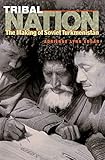Tribal Nation : The Making of Soviet Turkmenistan / Adrienne Lynn Edgar.
Material type: TextPublisher: Princeton, NJ : Princeton University Press, [2006]Copyright date: ©2004Edition: Course BookDescription: 1 online resource : 12 halftones. 3 mapsContent type:
TextPublisher: Princeton, NJ : Princeton University Press, [2006]Copyright date: ©2004Edition: Course BookDescription: 1 online resource : 12 halftones. 3 mapsContent type: - 9780691127996
- 9781400844296
- 958.5/084 958.5084
- DK938.85
- online - DeGruyter
- Issued also in print.
| Item type | Current library | Call number | URL | Status | Notes | Barcode | |
|---|---|---|---|---|---|---|---|
 eBook
eBook
|
Biblioteca "Angelicum" Pont. Univ. S.Tommaso d'Aquino Nuvola online | online - DeGruyter (Browse shelf(Opens below)) | Online access | Not for loan (Accesso limitato) | Accesso per gli utenti autorizzati / Access for authorized users | (dgr)9781400844296 |
Frontmatter -- CONTENTS -- MAPS AND ILLUSTRATIONS -- ACKNOWLEDGMENTS -- NOTE ON TRANSLITERATION -- INTRODUCTION. Tribe, Class, and Nation in Turkmenistan -- PART I. MAKING A NATION -- CHAPTER ONE. Sources of Identity among the Turkmen -- CHAPTER TWO. Assembling the Nation: The Creation of a Turkmen National Republic -- CHAPTER THREE. Ethnic Preferences and Ethnic Conflict -- CHAPTER FOUR. Helpers, Not Nannies -- CHAPTER FIVE. Dueling Dialects -- PART II: CONSTRUCTING SOCIALISM -- CHAPTER SIX. A Nation Divided -- CHAPTER SEVEN. Cotton and Collectivization -- CHAPTER EIGHT. Emancipation of the Unveiled -- CONCLUSION. From Soviet Republic to Independent Nation-State -- GLOSSARY OF TERMS AND ABBREVIATIONS -- BIBLIOGRAPHY -- INDEX
restricted access online access with authorization star
http://purl.org/coar/access_right/c_16ec
On October 27, 1991, the Turkmen Soviet Socialist Republic declared its independence from the Soviet Union. Hammer and sickle gave way to a flag, a national anthem, and new holidays. Seven decades earlier, Turkmenistan had been a stateless conglomeration of tribes. What brought about this remarkable transformation? Tribal Nation addresses this question by examining the Soviet effort in the 1920s and 1930s to create a modern, socialist nation in the Central Asian Republic of Turkmenistan. Adrienne Edgar argues that the recent focus on the Soviet state as a "maker of nations" overlooks another vital factor in Turkmen nationhood: the complex interaction between Soviet policies and indigenous notions of identity. In particular, the genealogical ideas that defined premodern Turkmen identity were reshaped by Soviet territorial and linguistic ideas of nationhood. The Soviet desire to construct socialist modernity in Turkmenistan conflicted with Moscow's policy of promoting nationhood, since many Turkmen viewed their "backward customs" as central to Turkmen identity. Tribal Nation is the first book in any Western language on Soviet Turkmenistan, the first to use both archival and indigenous-language sources to analyze Soviet nation-making in Central Asia, and among the few works to examine the Soviet multinational state from a non-Russian perspective. By investigating Soviet nation-making in one of the most poorly understood regions of the Soviet Union, it also sheds light on broader questions about nationalism and colonialism in the twentieth century.
Issued also in print.
Mode of access: Internet via World Wide Web.
In English.
Description based on online resource; title from PDF title page (publisher's Web site, viewed 08. Jul 2019)


